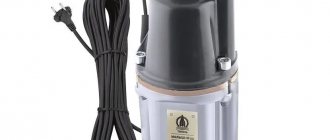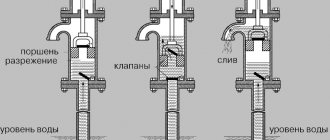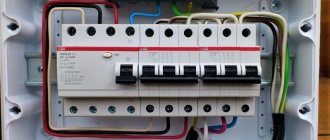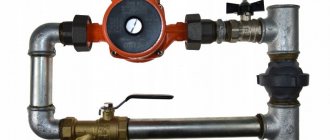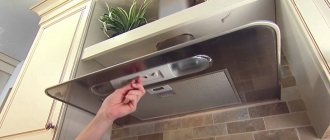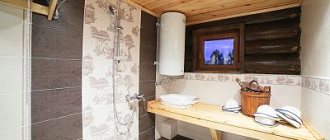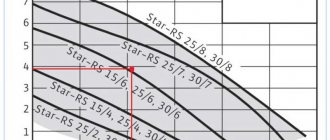Downhole submersible pumps are equipped with single-phase, in most cases brushless asynchronous motors. A special starting capacitor is installed in the connection mechanism. The electric motor stator is attached to the housing monolithically. In most cases, epoxy glue is used to fix it.
In devices of a monolithic design, the motor should be squeezed out of the glass by pressing on a special outlet for connecting the diverted pipeline when the impellers are dismantled. In rod devices, the motor component is dismantled when the two halves are separated, and in screw devices, after removing the working screw. In each situation, you can work with the inside of the motor after removing the sealed plug, which is secured with several screws on the sleeve, as well as a special locking ring. In some models, you need to use a special puller to remove the plug.
Each submersible pump motor contains oil, which is responsible for lubrication, dielectric and cooling functions. For this purpose, a special edible oil is used, which is commercially available. The oil requires replacement when its color becomes a little cloudy, mixes with water, begins to darken, or contains certain mechanical impurities. If the quantity and condition of the oil are in order, you need to pour it into a dry container, turning the motor over so that the remaining lubricant gradually drains out. If the oil level in the engine is too low, there are problems with the oil seals.
Worn bearings can also cause problems with the operation of the motor. Changes in shaft condition can result from operating the pump under extreme conditions. Burnt wiring and stators are beyond repair, but replacing them is not difficult.
Prolonged dry operation is the main cause of pumping device failure, apart from contamination. Due to the lack of liquid, the installed centrifugal impellers will always heat up and gradually sinter. Therefore, there will be no other options other than replacing devices. The situation is exactly the same with all landing bushings, as well as the auger. If the impellers jam, the shaft may rotate in the mounting holes. In high-power pumps, this shaft may become deformed or completely fail.
In auger devices, landing bushings and screws are considered consumables that must be replaced within 3-5 years, depending on the level of intensity of use. The main causes of malfunctions are the aging of components and prolonged exposure to small abrasive particles.
It should be noted that the components of borehole submersible pumps are adjusted to the product with high precision processing. For this reason, the device can be assembled and disassembled without much difficulty. If the installation sequence of components is not correct, the components may not fit into place. The design features of each individual model have certain differences from the others. Each assembly diagram provides practical recommendations for disassembling the pump yourself.
Pumping station malfunctions
In general, it is believed that if malfunctions appear in the Gilex Jumbo pumping station, then you should not fix them yourself. The simple design of the device does not guarantee its high-quality repair if it is not carried out by a specialist. But let's identify common problems that can stop the unit from working.
The most common situation is that everything seems to be working, but there is no water in the system. There are several reasons for this.
- We need to see if there is water in a hydraulic structure. Perhaps it has sunk so low that the lower tap of the hose does not catch it.
- The supply hose may be leaking. It simply tore in the area from the water to the pump. Therefore, the unit only draws in air.
- Perhaps a mud jam has formed inside the well or borehole, into which the edge of the hose has rested. Or the check valve is stuck.
- Outside the city, problems with the quality of electricity supply are common. So the voltage may drop, causing the pump motor to not spin as fast as it should. This means that the pump simply cannot raise water to a certain height.
The membrane is torn
Another common malfunction is that the pump often turns on and off. What are the reasons.
- The main one is that the membrane inside the accumulator has broken. You can check this very simply. There is a plastic cover on the back of the tank. If you dismantle it, you can find a nipple underneath it. Press on it, if water comes out from under it, it means the pear is torn. By the way, replacing the rubber membrane in the Jumbo pumping station is not so difficult.
- The air pressure inside the hydraulic tank has dropped. This can be determined by a pressure gauge, which is installed on the tank. It is necessary to drain the water from the container and see what the pressure gauge shows. If not below 1.5 atm, then this is the norm. If it is lower, you will have to pump it through the same nipple using a regular car pump. Of course, you will have to find the air leak and fix it.
- The pressure switch does not work.
How to pump air
And another malfunction is when the pump hums and does not rotate.
- A common reason is that the rotor is jammed in the bearings (and, accordingly, the impeller) due to the loss of their lubrication. You just need to remove the back cover of the device and turn the impeller, which cools the pump.
- Again, the cause may be low voltage in the supply network.
- The capacitor located in the terminal box of the pump may burn out, which is unlikely. But if there are no other reasons, then the capacitor should be checked last.
In principle, anything can happen to the Gilex pumping station
Therefore, it is very important to install it correctly and periodically carry out maintenance.
Check before commissioning
Before using the drainage pump, carefully inspect the housing, hydraulic parts and engine. If the shaft is cracked, it needs to be replaced. Rotor curvature is controlled by mechanical and thermal straightening. The impellers are suitable for operation if they do not have cracks, and the wear of the blades and disks is no more than 25% of the original dimensions. Bend of the blades is not allowed. Areas damaged by corrosion are cleaned and metal is deposited, followed by processing and balancing of the structure. the cracks are welded.
If the equipment starts up after a long period of inactivity, the rotor must be turned manually and checked for smooth operation and absence of blocking. It is imperative to make sure that the bearings have lubricant, and also purge the pressure gauge. Once the pump is filled with water, the electric motor is turned on. The pressure is checked with the inlet valve closed (zero flow) according to the readings of the pressure gauge. After this, the valve is opened and the nominal operating mode is established. If necessary, adjust the cooling system fluid pressure.
The pump's performance is monitored daily by checking:
- instrument readings;
- tightness of connections;
- leaks through the stuffing box;
- heating of bearings.
If during operation there are sharp fluctuations in the pressure gauge needle, increased noise and vibration, this indicates an emergency situation. In this case, work is stopped to identify and eliminate faults.
Installation rules
Like all pumping stations, Gilex Jumbo units should be installed only in insulated rooms, because this equipment can operate at temperatures not lower than +1C, but not higher than +30C. The simplest solution is the basement of the house. But everything will depend on the model of the unit used. For example, the same device of the Jumbo 70/50 brand is a very noisy installation, so it is better to install it in a utility room or inside a caisson. Low-power models can be installed in the basement.
Correct installation
And the main requirement for installation is a flat and durable surface. And although Gilex pumping stations use centrifugal devices, they still vibrate
Therefore, it is very important to install the unit level and secure it well.
And one last thing. All pumping units from the Gilex company are inexpensive models that are affordable for any resident of suburban areas. In addition, all equipment is adapted to Russian operating conditions, especially with regard to voltage drop in the supply network. So Gilex will withstand everything.
Rewind the reel
If you need to rewind the vibration pump coil, prepare the following consumables and tools:
- wire brand PETV;
- set for replacing epoxy compound (epoxy resin, plasticizer, hardener);
- electric stove;
- winding machine (can also be done manually);
- soldering iron;
- hammer.
While rewinding the coil, you will need to melt the epoxy compound. It is toxic, so carry out the work outside or in the garage. Place the filled electromagnet on the tile and wait until the epoxy heats up to 165 degrees. This will be visible from the toxic haze that appears.
Carefully knock the electromagnet out of the housing on a wooden object, while the electromagnet looks straight down. When the magnet changes its position, remove it. We clean the heated body from epoxy resin, using a screwdriver or a metal brush.
We knock the electromagnet out of the coil with a wooden wedge.
We do not clamp the coils in a vice, we only hold them with our hands.
Once the magnet is removed, unwind the coil, removing all the epoxy.
Using a winding machine, wrap the spool completely. Here you can do without a machine, but it will take longer to wrap it by hand.
Solder the ends of the wire to the main part, now we mount the electromagnetic core into the coil body. We solder the power cable to the beginning of the new winding. It is permissible to “seat” the coils by lightly tapping the core.
After mixing the epoxy with the plasticizer and adding the hardener, we pour it into the vertically fixed body of the device. Fill the compound to the top of the electromagnet, wait 10 minutes and add the compound again (after filling all the cracks, it will settle). After 24 hours, we assemble the pump and check its functionality.
Basic malfunctions of submersible pumps
Before disassembling the Whirlwind CH-90V pump, you need to remember that any submersible model consists of 2 parts: a pumping (working) part and a drive part.
One of the malfunctions of the electrical part of the pump is a failed capacitor Source https://sovet-ingenera.com
This means that malfunctions of the Whirlwind pump can also be divided according to these characteristics.
Among the most common malfunctions, there are several that can result from breakdowns in both parts of the machine.
Malfunction No. 1 – the pump does not work
Failure to operate may occur due to malfunctions in the pumping and electrical parts. A common cause of the problem is the activation of the electrical protection system. The system can work due to any problem in the circuit: “pump motor” – “power cable” – “circuit breaker or fuse” – “power supply”. If the pump does not turn on, then it must be disconnected from the network, removed from the well and inspected. Before checking the engine, check the integrity of the cable, as well as the quality of the connection “mains socket - plug of the pump power cable”.
Possibility of damage to the power cable Source https://mtdata.ru
If the cable, socket and plug are in good condition, check the serviceability of the circuit breakers or fuses (plugs). The serviceability of all components of the circuit indicates that the problem lies in the engine.
Interesting! To conduct a quick analysis of the engine’s serviceability, just sniff its body. The specific “aroma” of burnt insulation cannot be contained by any means or confused with other odors. Its presence indicates only one thing - the pump cannot be repaired, it needs to be replaced.
If there is no smell, it is advisable to disassemble the product by separating the pump part from the engine. To check, the machine is briefly plugged into the network. A working motor will hum and its shaft will begin to rotate. After starting rotation, the motor must be immediately disconnected from the network - submersible types are cooled by the pumped liquid. Their long-term operation “dry” will lead to failure. If the motor is “silent” and the shaft does not rotate, then its winding can be checked with a multimeter.
Separated parts of the pump Source https://starimpex.ru
An ohmmeter (multimeter), set to the “200 Kom” position or a value close to it, is connected to the motor winding. To do this, one probe of the device is applied to one plug of the power plug, and the second probe is applied to the other plug. Any needle deviation or digital reading indicates the integrity of the winding. The immobility of the arrow or the absence of readings on the digital display (may show “0”) indicates a break in the winding. In this case, the pump is also replaced. When checking with a multimeter, you need to remember that this method may give an incorrect result if the motor design includes a starting capacitor. Its presence in the composition must be indicated in the product passport.
Photo of the passport indicating the presence of a capacitor box Source https://ad-cd.net
The capacitor can be installed in a separate box, or it can be built inside the pump body. Together with the capacitor, a thermal relay can be installed in the housing.
Attention! As an additional check, you can check the motor for insulation breakdown, but for this check you need a megger or multimeter with this function. If the pump is lowered into the well on a steel cable and connected to the network, then a person standing on the ground and holding the cable with his “bare” hand will feel a “breakdown” of the engine without any instruments.
The problem can also arise if the pump part is faulty. Most often, a failure occurs if, for some reason, the motor torque is no longer supplied to the working part. This may be shaft jamming due to blockage, silting or salting of rotating parts, a screw break in screw types, a key breakage in vortex types, or damage to the impeller in centrifugal types.
Blockages identified after disassembling the Vikhr SN-90V pump Source https://santeh-elektrik.ru
Blockages can be deposited not only on the moving parts of the machine. Blockages formed on the check valve can cause no less harm. This can lead to another problem - a sharp drop in water pressure.
Malfunction No. 2 - the pump hums, but does not pump water or pumps very weakly
This problem can also occur for several reasons. In addition to clogging of the pump part, this may be wear on the impeller in centrifugal machines or impellers in vortex structures. The reason for low pressure in screw machines can be significant wear of the “hub-screw” pair. In some cases, a decrease in pressure for all types of pumps may occur due to low water levels in the well. Clogged mechanical filters installed on the suction side can also cause a drop in pressure and even its disappearance. From the electrical side, the reason for the decrease in pressure may be the failure of the starting capacitor of the electric motor. In this case, the engine will hum and even (possibly) spin slowly, but it will not reach normal operating speeds.
The video below shows the state of the pump with a faulty capacitor and after replacing it:
Prolonged humming of the engine in the absence of water supply or its low pressure can lead to its failure.
Problem No. 3 – the pump supplies water in jerks or with air
The main reason for this problem may be a decrease in the water level in the well. The cause of this phenomenon is difficult to determine, so the simplest and most effective solution is to lower the pump to a greater depth. If the depth of the well does not allow this, then a possible solution to the problem may be to reduce the performance of the pump. Before deciding on any action, it is necessary to double-check the depth of the well.
For screw machines, the problem may be caused by wear of the “bushing-screw” pair or a break in the thread at the point where the screw is attached to the motor shaft. A break or significant wear of the impeller mounting key can cause this problem in centrifugal machines. When using vortex types, this disadvantage may occur if the impeller slips along the shaft of the pump part.
Repair of the “Vikhr” CH-90V borehole pump can be viewed here:
When solving this problem, it would be a good idea to double-check the quality of all electrical connections and the integrity of the cable supplying the pump.
Fault No. 4 – increased energy consumption
A significant increase in energy consumption can be caused by various reasons. Siltation, clogging, and wear of parts of the working parts of pumps can cause this problem on the part of the pumping part of the machine. Damage to the power cable, poor electrical contact at connections and connections, capacitor failure and other similar problems will lead to increased consumption from the motor part. Significant excess energy consumption can cause difficulties with the shaft bearings included in the pump. If for some reason the bearings begin to rotate tightly, with “jamming,” then the engine has to develop more force to turn them, and therefore consume more energy.
Whirlwind pump with capacitor box and power cable Source https://www.luchysveta.ru
Elimination of this malfunction is solved in the same ways - disassembling the machine, inspecting parts and working parts and replacing them if necessary.
Problem No. 5 – constant tripping of electrical protection
The most important reason for this malfunction is mechanical damage to the insulation of the supply cable. “Knocking out the plugs” can result from a breakdown of the engine insulation, jamming of the motor rotor bearings or the pump shaft, or difficulty in rotating the shafts as a result of blockages. Getting rid of the problem will be achieved by disassembling and repairing the machine, during which it is necessary to carefully check the electrical part of the pump. It would be useful to check the insulation condition of the motor windings and power cord. To carry out the test, one probe of a megger, or a multimeter with this function, is applied to one plug of the power cord plug, and the second to the body of the machine. For a working product, after measurement, the device should show at least 500 MOhm.
Preventive measures
To prevent or minimize the likelihood of serious breakdowns of downhole equipment, it is necessary to carry out high-quality preventive maintenance at annual intervals. This will allow timely identification of problems in the operation of nodes. The ideal time for manipulation is spring and autumn.
- Carefully remove the deep well pump from the damp environment. On the surface, carefully examine the housing for minor defects/scuffs, and also examine the condition of the electrical cable and hanging safety rope. If you do not pay attention to worn parts in a timely manner, this may lead to equipment breakage or fire due to a faulty electrical cable.
- Examine the pump for deformation, dirt or corrosion. The components must be thoroughly cleaned and rinsed with plenty of clean water.
If a large amount of silt or sand accumulates on the surface of the housing, this indicates sanding of the well. Therefore, it requires washing. Having lowered the pump into a container of clean water, you need to turn it on and check for extraneous noise. If any are observed, one of the nodes is not working correctly.
Problems with well pumps are not uncommon. This is usually due to non-compliance with operating and maintenance rules. You need to take care of the operation of the pumping station at the stage of purchase. It is important to choose the right model with optimal power, since a high-power model will run idle, wearing out parts, and a low-power model, due to technical limitations, will not be able to satisfy the buyer’s needs. Housing and communal services or Vodokanal employees will be able to help in this matter.
Briefly about the main thing
Disassembling modern well pumps is not a difficult task, but at the same time, it requires attention, technical literacy and perseverance. The production technology of machines of this type is based on maximum simplicity and accessibility. Any modern pump does not contain any complex or hard-to-reach parts; their repair does not require special repair conditions or expensive diagnostic devices. Therefore, you can disassemble and repair Whirlwind machines yourself, at home.
What do you think – with the instructions “at hand”, will a novice master be able to cope with disassembling and repairing the “Vikhr” well pump or not?
Causes of breakdowns
The rapid depletion of the resource is explained by the difficult conditions in which the equipment has to work. Constant exposure to the liquid in which the unit is immersed, vibration, temperature changes and friction of abrasive particles of water suspension ultimately lead to equipment malfunctions. It should be mentioned that more expensive models, for example, the Gilex or Grundfos pump, are noticeably more durable and reliable than their cheap counterparts.
There are several main reasons why downhole equipment stops performing its functions.
- Wear. The performance of components gradually deteriorates, parts become unusable after a certain period of operation.
- Installing the mechanism above the water level. The equipment begins to work outside the liquid environment, “dry”, as a result of which it is deprived of water lubrication and cooling of the heating working parts. Overheating of equipment can lead to jamming of parts and even melting of plastic components.
- The power exceeds the required level, the unit begins to suck in a large amount of soil from the bottom of the well or well. Constant exposure to abrasive particles significantly accelerates the wear of the impeller, and the part breaks prematurely.
- Lack of voltage stabilizer. The electrical parts of the product, including capacitors, are very sensitive to voltage surges and power failures. If the owner of the equipment does not use a voltage stabilizer, sooner or later the electrical parts of the unit will fail.
- Neglect of prevention. Experts recommend conducting regular technical inspections of equipment 1-2 times a year. Periodically checking the condition of the submersible unit allows you to promptly identify wear of components and other problems. Prevention allows you to prevent serious breakdowns, the elimination of which will cost the equipment owner much more than regular maintenance.
Criterias of choice
At the time of purchasing a pumping station, the master must rely on the following operating parameters of the unit:
- Power. The larger it is, the greater the number of tasks that the equipment can handle. For example, you can use an 800 W station just to supply water to the house. If you plan to additionally water your garden/vegetable garden at your dacha, you need to buy a more powerful unit.
- Suction depth. Take into account the distance of the source from the house.
- Hydraulic tank volume. For a family of 2 people, 24 liters is enough. For 3 or more residents you need to take a station with a tank of 50 liters or more.
- Case material. Cast iron and steel can be used in more field conditions than polymer. Although plastic dampens noise from a running engine more effectively.
- The presence of a remote ejector (if water is expected to rise from great depths).
Additionally, you should pay attention to the various protective functions of the equipment: dry-running system, automatic control, leakage protection, etc.
Nuances of repair
In the cases listed above, an experienced equipment owner can repair the submersible pump with his own hands - clean clogged parts or install new ones. Repair instructions can be found on numerous videos on the Internet. But experts still recommend contacting special service centers, since the repair of submersible pumps of different brands has its own nuances, which the owner of the equipment may not be familiar with.
For example, with Gilex brand equipment, repairs most often involve adding oil to the engine. Devices of this brand are equipped with oil-filled engines, in which oil leakage can cause malfunctions and damage to other components. To add oil to the Gilex pump, professionals strongly recommend using the original product. Many equipment owners believe that they can add a substitute such as glycerin or transformer oil, but in the end such dubious savings only lead to accelerated wear and tear of the device.
The most common problem with Malysh brand products is loud noise that occurs even without pumping out water. The cause of the problem is a rupture in the central axis of the unit. The noise occurs because the broken axle no longer holds the armature and the membrane. The problem is resolved by replacing the part.
In addition to the fact that service center specialists are familiar with repairing water pumps from any manufacturer, when you contact them for a service, they provide free diagnostics of the devices. Therefore, before starting to repair a submersible centrifugal pump with your own hands, the owner of the equipment must consider all the options and take into account the pros and cons of each of them.
How to disassemble correctly
First, turn off the power, then dismantle, disconnect the pressure pipeline and disassemble it:
- remove the coarse filter;
- disconnect the motor part from the hydraulic part.
Disassembling the hydraulic unit:
- the hydraulic part is clamped with a vice onto the pressure pipe;
- the housing is unscrewed;
- All parts are removed from the shaft;
- if necessary, replace worn or broken ones;
- the parts are washed and then assembled onto the shaft.
Important: in order not to confuse the parts, they must be placed in the order of disassembly or put on any axis/rod without changing position.
Motor disassembly:
- it is installed with the lid facing up;
- unscrew the lid and remove the sealing gasket;
- oil is drained;
- using a press, the lower motor cover is pushed down, the locking ring is released, and then removed;
- with light blows of a mallet on the end of the shaft, the bottom cover with the rotor is knocked out;
- the engine rotor with bearings is removed;
- if replacement is necessary, remove the bearings from the shaft and the oil seal from the top cover of the motor;
- windings are checked; if necessary, the stator is sent for repair. Assembly is carried out in the reverse order.
Kinds
The range of pumping stations of the Russian Vikhr brand is quite wide, however, in each product line there are models that are most preferred by customers. The company's most popular and in-demand pressure equipment:
- automatic station “Vikhr” ASV – 1200/24N;
- water supply device “Vikhr” ASV – 800/19;
- water supply system “Vikhr” ASV – 370/2Ch;
- water pumping station “Vikhr” ASV – 800/50;
- borehole pump “Vikhr” SN – 50.
To determine the choice of the appropriate model of pressure equipment, it is necessary to carefully study all the characteristics of the model range.
Device ASV-1200/24N
This type of pumping station is designed for clean water. It is equipped with high quality construction and reliable automatic control system. The unit has a long operating period without deterioration in functionality. It has many advantages, including:
- energy efficiency;
- body made of cast iron, which does not rust and is also resistant to various mechanical influences;
- built-in barometer that allows you to control pressure changes in the system;
- high pressure;
- fully automatic operation mode;
- silent operation (the device is suitable even for houses with low sound insulation).
ASV device – 370/2Ch
- the presence of a metal receiver consisting of two parts and a membrane partition;
- design made of cast iron alloy, resistant to mechanical damage and environmental influences;
- presence of automatic thermal protection.
The suction depth of the device is 9 m, the tank volume is 2 l.
Downhole pump SN-50
This device is designed to supply clean water from wells or wells, the depth of which is no more than 50 meters. The design is made of high-quality stainless steel, which minimizes the occurrence of corrosion processes and also prevents mechanical and other damage from environmental influences. The device is compact, easy to use and allows you to pump water from wells with a diameter of 100 mm.
Advantages and disadvantages
Vikhr pumping equipment has earned a reputation as affordable, proven, efficient, thanks to the following advantages:
- reasonable energy consumption, which is important for most families;
- availability of automatic pressure support;
- an asynchronous motor in each station, which is characterized by increased resistance to wear;
- built-in ejector;
- the strength of the impeller, its resistance to abrasive impurities in water.
Vikhr stations are easy to use, light in weight, and exhibit moderate noise during operation. An additional advantage is the constant availability of spare parts (repair kits) on the market in case of need for repair work. At the Vikhr station the manufacturer gives a one-year warranty.
- Some craftsmen consider Russian production to be a relative disadvantage. But Vikhr stations have been proving for years that domestic products are no worse than European ones.
Source: https://strojdvor.ru/vodosnabzhenie/nasosnaa-stancia-vihr/
